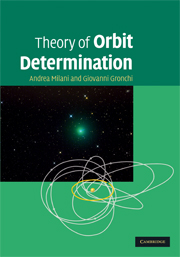Book contents
- Frontmatter
- Contents
- PREFACE
- Part I Problem Statement and Requirements
- Part II Basic Theory
- Part III Population Orbit Determination
- 7 THE IDENTIFICATION PROBLEM
- 8 LINKAGE
- 9 METHODS BY LAPLACE AND GAUSS
- 10 WEAKLY DETERMINED ORBITS
- 11 SURVEYS
- 12 IMPACT MONITORING
- Part IV Collaborative Orbit Determination
- References
- Index
7 - THE IDENTIFICATION PROBLEM
from Part III - Population Orbit Determination
Published online by Cambridge University Press: 05 June 2012
- Frontmatter
- Contents
- PREFACE
- Part I Problem Statement and Requirements
- Part II Basic Theory
- Part III Population Orbit Determination
- 7 THE IDENTIFICATION PROBLEM
- 8 LINKAGE
- 9 METHODS BY LAPLACE AND GAUSS
- 10 WEAKLY DETERMINED ORBITS
- 11 SURVEYS
- 12 IMPACT MONITORING
- Part IV Collaborative Orbit Determination
- References
- Index
Summary
The identification problem is the attempt to find, among independent detections of celestial bodies, those belonging to the same physical object. The problem becomes more difficult as the population of observed objects increases (see Chapter 11). This chapter is based on (Milani 1999, Milani et al. 2000a, Milani et al. 2001a) and ongoing research. The main example is the population of small Solar System bodies. Most of the observable ones are asteroids, although the observed population contains a smaller fraction of comets and others. We will use the word asteroid in the following discussion, although it applies also to the other populations.
An asteroid is typically observed only over a time span of a few hours to a few weeks, and is bright enough to be visible only over the apparition, a time interval spanning at most a few months. If this time span is not exploited in full, the single apparition orbit determination either is impossible or results in a rapidly growing prediction uncertainty: by the time of the next apparition the asteroid could be in a portion of the sky larger than the field of view of the telescopes available for the recovery. Thus we have a lost asteroid, that is, it is more likely to be rediscovered by chance than by looking at the predicted position. The databases of detected Solar System objects contain many single apparition arcs: the goal is to join together those of the same object, allowing for an accurate orbit determination.
Information
- Type
- Chapter
- Information
- Theory of Orbit Determination , pp. 113 - 136Publisher: Cambridge University PressPrint publication year: 2009
